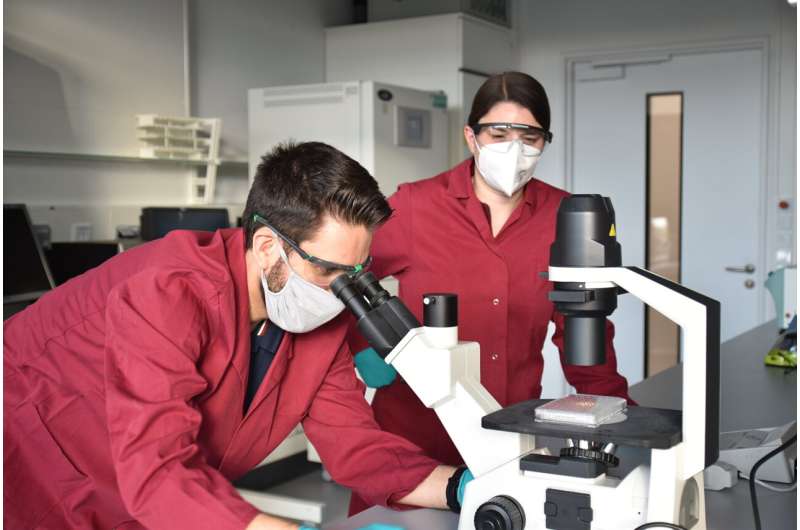Exploring antiviral potential of natural products against flu viruses

Fever, cough, sore throat, and general malaise—the cold season is here, and not only corona but also influenza viruses are spreading again at a rapid pace. Influenza A and B viruses cause severe, contagious infections that can even be fatal if complications arise. The most effective protection against the ever-changing virus strains is the annual vaccination.
However, if an infection occurs, only two classes of drugs are approved in most countries, including Germany. Scientists at the Fraunhofer Institute for Molecular Biology and Applied Ecology IME in Giessen and the Hessian LOEWE Center for Translational Biodiversity Genomics (LOEWE TBG) see great therapeutic potential in natural substances to inhibit influenza viruses in the future. They provide new impetus in a scientific review.
Worldwide, the annual influenza epidemics lead to an estimated three to five million severe cases of illness, of which around 10% are fatal. One reason for these high numbers is the rapid mutability of influenza viruses. This makes it necessary to adapt the vaccine every year.
If, however, contrary to expectations, a different or new strain of the virus triggers an epidemic or even a pandemic, there is initially no effective vaccine available, as was the case in the pandemic in 2009, which is remembered as swine flu and which was triggered by an influenza virus of the H1N1 subtype. It is not only in such dramatic years that new drugs would be helpful to contain the multiplication of influenza viruses.
So far, only M2 channel blockers and neuraminidase inhibitors have been approved for therapy in many countries. In addition, other drugs are already available in some countries, for example in the U.S. and Japan, but these are also only effective to a limited extent—after all, many influenza strains have already developed resistance and lost their sensitivity to these active substances.
A team of scientists from the Fraunhofer Institute for Molecular Biology and Applied Ecology IME in Giessen and the Hessian LOEWE Center for Translational Biodiversity Genomics (LOEWE TBG) therefore pleads for research into further possibilities for treating influenza infection. They have their eye on the wide range of natural products produced by microbes and animals.
In a paper published in the journal Viruses, they give an overview of the drugs approved so far and then discuss the therapeutic potential of natural products that inhibit replication of the influenza virus. With their compilation, they provide new impulses for the future development of new influenza drugs.
The researchers communicate an urgent need for new active agents against a broad spectrum of influenza subtypes. Natural products have already made an important contribution to the identification of new lead structures, especially in the field of infectious diseases.
"Promising natural products include animal toxins, antiviral substances in fungi and also bacteria, which are not only interesting for antibiotics but also for drugs against viruses. The enormous diversity and structural complexity make natural products a promising starting point for researching and identifying new compounds that could be effective against influenza viruses. By means of genomic analyses, related compounds can be further identified and examined for their antiviral effect," explains study leader Dr. Kornelia Hardes.
The head of a BMBF junior research group in the field of infection research at the Fraunhofer Institute IME and the LOEWE Center TBG is herself analyzing natural substances from fungi, bacteria and insects that appear promising for use as drugs to treat influenza illnesses.
"The fact that there is no really efficient therapy against flu led me to this research focus," adds the licensed pharmacist. In her opinion, combined therapies with several drugs are also considered too rarely, although studies have shown good results.
Which virus subtypes are currently circulating is identified by genomic analyses. This makes it possible to monitor both the dynamics of outbreaks and the development and spread of resistance. However, the challenges of bringing promising substances into drug development are big: different analytical methods make it difficult to compare the results, and data such as on the development of resistance are not available.
Added to this are the high costs of testing procedures. "However, if one considers not only the health benefits but also the heavy socio-economic burden that the costs associated with the disease represent for health systems, new drugs are urgently needed," says Hardes.
Genomic research into natural products forms one of four research priorities at the LOEWE Center TBG. Prof. Dr. Andreas Vilcinskas and Dr. Tim Lüddecke, also authors of the scientific article, are researching the potential of animal toxins produced by stingrays, spiders, or snakes, for example. The focus is always on considerations of how the results can be used for further pharmaceutical research and concrete application.
More information: Johanna Eichberg et al, Antiviral Potential of Natural Resources against Influenza Virus Infections, Viruses (2022). DOI: 10.3390/v14112452


















